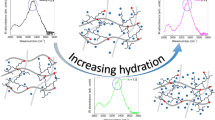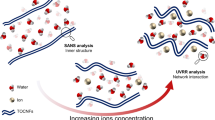Abstract
Cellulose nano-sponges (CNS), obtained by cross-linking TEMPO oxidized and ultra-sonicated cellulose nano-fibers (TOUS-CNFs) with branched polyethyleneimine (bPEI), underwent here a systematic small angle neutron scattering investigation, by varying the amount of cross-linker and the water content. The aim was to provide experimental evidence of nano-porosity in the TOUS-CNF network of these nano-sponges (CNSs) by investigating the water nano-confinement geometries in the adsorbent material. Moreover, we also verified how the breaking/reformation of specific intermolecular hydrogen bond interactions between water and the chemical groups present in the architecture of the CNSs could contribute to regulate the water adsorption process observed at macroscopic level. The analysis of the experimental data, performed in terms of the correlation length model, allowed us to extract the short-range correlation length ξ, interpreted as a very first indirect estimation of the effective nano-dimension of the cavities produced by the cross-linking of the reticulated cellulose nano-fibers. From the model, power-law (n) and Lorentzian (m) exponents have been also obtained, associated with the density of TOUS-CNFs at high (larger than hundreds of Å) and low (~ 10–100 Å) spatial scales, respectively. These parameters were all sensitive to the structural variations induced by the progressive uptake of water on the bPEI/TOUS-CNF sponges with different bPEI:TOUS-CNF (w/w) ratios. Finally, we investigated the effect of the addition of citric acid in the CNS formulation, confirming its role in increasing cross-linking density and sponge rigidity. The obtained results appear crucial in order to rationalize the design of these sponges and to track the changes in the ability of the final products as efficient nano-confinement systems for water.
Graphic abstract












Similar content being viewed by others
References
Agrawal SK, Sanabria-DeLong N, Jemian PR, Tew GN, Bhatia SR (2007) Micro- to nanoscale structure of biocompatible PLA–PEO–PLA hydrogels. Langmuir 23:5039–5044
Beaucage G (1996) Small-angle scattering from polymeric mass fractals of arbitrary mass-fractal dimension. J Appl Cryst 29:134–146
Behr J-P (1997) The proton sponge: a trick to enter cells the viruses did not exploit. Chimia 51:34–36
Blanchard EJ, Reinhardt RM, Graves EE, Andrews BK (1994) Dyeable cross-linked cellulose from low formaldehyde and non-formaldehyde finishing systems. Ind Eng Chem Res 33:1030–1034
Chang DR, Harden S, Loverro N (1986) Protonation of polyethylenimine. J Macromol Sci 23:801–804
Choudhury CK, Roy S (2013) Structural and dynamical properties of polyethylenimine in explicit water at different protonation states: a molecular dynamics study. Soft Matter 9:2269–2281
Coma V, Sebti I, Pardon P, Pichavant FH, Deschamps A (2003) Film properties from crosslinking of cellulosic derivatives with a polyfunctional carboxylic acid. Carbohydr Polym 51:265–271
Corsi I, Fiorati A, Grassi G, Bartolozzi I, Daddi T, Melone L, Punta C (2018a) Environmentally sustainable and ecosafe polysaccharide-based materials for water nano-treatment: an eco-design study. Materials 11:1228
Corsi I, Winther-Nielsen M, Sethi R, Punta C, Della Torre C, Libralato G, Lofrano G, Sabatini L, Aiello M, Fiordi L, Cinuzzi F, Caneschi F, Pellegrini D, Buttino I (2018b) Ecofriendly nanotechnologies and nanomaterials for environmental applications: key issue and consensus recommendations for sustainable and ecosafe nanoremediation. Ecotox Environ Safe 154:237–244
Fiol N, Vásquez MG, Pereira M (2019) TEMPO-oxidized cellulose nanofibers as potential Cu(II) adsorbent for wastewater treatment. Cellulose 26:903–916
Fiorati A, Turco G, Travan A, Caneva E, Pastori N, Cametti M, Punta C, Melone L (2017) Mechanical and drug release properties of sponges from cross-linked cellulose nanofibers. ChemPlusChem 82:848–858
Fiorati A, Pastori N, Punta C, Melone L (2019) Spongelike functional materials from TEMPO-oxidized cellulose nanofibers. In: Trotta F, Mele A (eds) Nanosponges: synthesis and applications. Wiley-VCH, New York, pp 123–141
Habibi Y (2014) Key advances in the chemical modification of nanocelluloses. Chem Soc Rev 43:1519–1542
Hammouda B (2006) Solvation characteristics of a model water-soluble polymer. J Polym Sci B Polym Phys 44:3195–3199
Hammouda B, Ho DL, Kline S (2004) Insight into clustering in poly(ethylene oxide) solutions. Macromolecules 37:6932–6937
Hammouda B, Horkay F, Becker ML (2005) Clustering and solvation in poly(acrylic acid) polyelectrolyte solutions. Macromolecules 38:2019–2021
Horkay F, Basser PJ, Hecht A-M, Geissler E (2005) Structural investigations of a neutralized polyelectrolyte gel and an associating neutral hydrogel. Polymer 46:4242–4247
Hule RA, Nagarkar RP, Altunbas A, Ramay HR, Branco MC, Schneider JP, Pochan DJ (2008) Correlations between structure, material properties and bioproperties in self-assembled beta-hairpin peptide hydrogels. Faraday Discuss 139:251–264
Hule RA, Nagarkar RP, Hammouda B, Schneider JP, Pochan DJ (2009) Dependence of self-assembled peptide hydrogel network structure on local fibril nanostructure. Macromolecules 42:7137–7145
Isogai A, Saito T, Fukuzumi H (2011) TEMPO-oxidized cellulose nanofibers. Nanoscale 3:71–85
Jiang F, Hsieh YL (2014) Super water absorbing and shape memory nanocellulose aerogels from TEMPO-oxidized cellulose nanofibrils via cyclic freezing–thawing. J Mater Chem A 2:350–359
Kargarzadeh H, Ahmad I, Thomas S, Dufresne A (2017) Handbook of nanocellulose and cellulose nanocomposites. Wiley, Hoboken. ISBN 978-3-527-68998-9
Keiderling U (2002) The new ‘BerSANS-PC’ software for reduction and treatment of small angle neutron scattering data. Appl Phys A 74:s1455–s1457
Kobayashi Y, Saito T, Isogai A (2014) Aerogels with 3D ordered nanofiber skeletons of liquid-crystalline nanocellulose derivatives as tough and transparent insulators. Angew Chem 126:10562–10565
Lee KY (2018) Nanocellulose and sustainability: production, properties, applications, and case studies. CRC Press, Boca Raton. ISBN 978-1-351-26290-3
Mahfoudhi N, Boufi S (2017) Nanocellulose as a novel nanostructured adsorbent for environmental remediation: a review. Cellulose 24:1171–1197
Melone L, Altomare L, Alfieri I, Lorenzi A, De Nardo L, Punta C (2013) Ceramic aerogels from TEMPO-oxidized cellulose nanofibre templates: synthesis, characterization, and photocatalytic properties. J Photochem Photobiol A: Chem 261:53–60
Melone L, Bonafede S, Tushi D, Punta C, Cametti M (2015a) Dip in colorimetric fluoride sensing by a chemically engineered polymeric cellulose/bPEI conjugate in the solid state. RSC Adv 5:83197–83205
Melone L, Rossi B, Pastori N, Panzeri W, Mele A, Punta C (2015b) TEMPO-oxidized cellulose cross-linked with branched polyethyleneimine: nanostructured adsorbent sponges for water remediation. ChemPlusChem 80:1408–1415
Millon LE, Nieh M-P, Hutter JL, Wan W (2007) SANS characterization of an anisotropic poly(vinyl alcohol) hydrogel with vascular applications. Macromolecules 40:3655–3662
Möller H, Grelier S, Pardon P, Coma V (2004) Antimicrobial and physicochemical properties of chitosan–HPMC-based films. J Agric Food Chem 52:6585–6591
Panzella L, Melone L, Pezzella A, Rossi B, Pastori N, Perfetti M, D’Errico G, Punta C, D’Ischia M (2016) Surface-functionalization of nanostructured cellulose aerogels by solid state eumelanin coating. Biomacromolecules 17:564–571
Pierre G, Punta C, Delattre C, Melone L, Dubessay P, Fiorati A, Pastori N, Galante YM, Michaud P (2017) TEMPO-mediated oxidation of polysaccharides: an ongoing story. Carbohydr Polym 165:71–85
Rossi B, Paciaroni A, Venuti V, Fadda GC, Melone L, Punta C, Crupi V, Majolino D, Mele A (2017) SANS investigation of water adsorption in tunable cyclodextrin-based polymeric hydrogels. Phys Chem Chem Phys 19:6022–6029
Rosta L (2002) Cold neutron research facility at the Budapest Neutron Centre. Appl Phys A 74:s52–s54
Saffer EM, Lackey MA, Griffin DM, Kishore S, Tew GN, Bhatia SR (2014) SANS study of highly resilient poly(ethylene glycol) hydrogels. Soft Matter 10:1905–1916
Shi R, Zhang Z, Liu Q, Han Y, Zhang L, Chen D, Tian W (2007) Characterization of citric acid/glycerol co-plasticized thermoplastic starch prepared by melt blending. Carbohydr Polym 69:748–755
Thomas B, Raj MC, AK B, RM H, Joy J, Moores A, Drisko GL, Sanchez C (2018) Nanocellulose, a versatile green platform: from biosources to materials and their applications. Chem Rev 118:11575–11625
Wang D (2019) A critical review of cellulose-based nanomaterials for water purification in industrial processes. Cellulose 26:687–701
Yun SI, Lai K-C, Briber RM, Teertstra SJ, Gauthier M, Bauer BJ (2008) Conformation of arborescent polymers in solution by small-angle neutron scattering: segment density and core–shell morphology. Macromolecules 41:175–183
Zhou T, Cheng X, Pan Y, Li C, Gong L (2019) Mechanical performance and thermal stability of polyvinyl alcohol–cellulose aerogels by freeze drying. Cellulose 26:1747–1755
Ziebarth JD, Wang Y (2010) Understanding the protonation behavior of linear polyethylenimine in solutions through Monte Carlo simulations. Biomacromolecules 11:29–38
Acknowledgments
The authors acknowledge the CERIC-ERIC Consortium for the access to experimental facilities and financial support. The project was funded by Regione Toscana, NanoBonD (Nanomaterials for Remediation of Environmental Matrices associated to Dewatering, Nanomateriali per la Bonifica associata a Dewatering di matrici ambientali) POR CReO FESR Toscana 2014–2020-30/07/2014-LA 1.1.5 CUP 3389.30072014.067000007. This work benefited from the use of the SasView application, originally developed under NSF award DMR-0520547. SasView contains code developed with funding from the European Union’s Horizon 2020 research and innovation program under the SINE2020 project, Grant Agreement No 654000.
Author information
Authors and Affiliations
Corresponding authors
Additional information
Publisher's Note
Springer Nature remains neutral with regard to jurisdictional claims in published maps and institutional affiliations.
Rights and permissions
About this article
Cite this article
Paladini, G., Venuti, V., Almásy, L. et al. Cross-linked cellulose nano-sponges: a small angle neutron scattering (SANS) study. Cellulose 26, 9005–9019 (2019). https://doi.org/10.1007/s10570-019-02732-2
Received:
Accepted:
Published:
Issue Date:
DOI: https://doi.org/10.1007/s10570-019-02732-2




